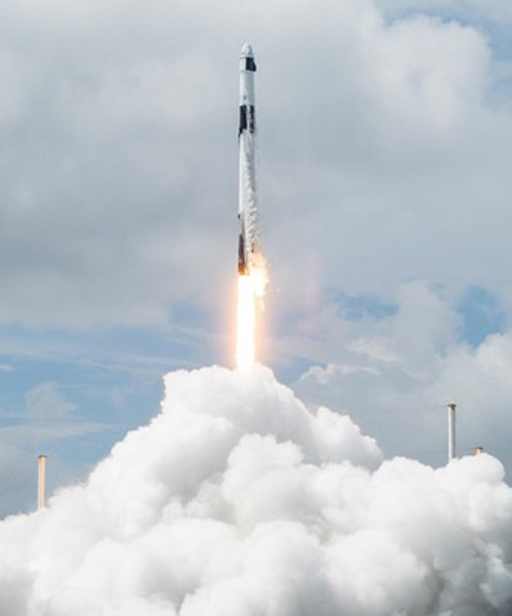1.3.1 Launch and return
The Apollo missions to the Moon were the first to collect rock and soil samples from the surface of another planetary body, with nearly 400 kg returned by the astronauts to be analysed in laboratories on Earth. Since then, robotic spacecraft have returned samples to Earth from the Moon, low Earth orbit (LEO, the area of space occupied by satellites and the International Space Station), asteroids, a comet and even the Sun. Table 3 summarises previous and currently planned sample return missions. Use your mouse to scroll left and right across the table, or click on the table and use your keyboard arrows.
| Table 3 Sample return missions | |||||||
|---|---|---|---|---|---|---|---|
| Mission Name | Space Agency | Launch date | Sample return date | Target Body | Amount of sample | Type of sample | Comments |
| Apollo 11 | NASA | 1969 | 1969 | Moon | 21.5 kg | Lunar soil and rock | First crewed lunar sample return mission |
| Apollo 12 | NASA | 1969 | 1969 | Moon | 34.4 kg | Lunar soil and rock | |
| Luna 16 | USSR | 1970 | 1970 | Moon | 101 g | Lunar soil | First robotic lunar sample return mission |
| Apollo 14 | NASA | 1971 | 1971 | Moon | 42.8 kg | Lunar soil and rock | |
| Apollo 15 | NASA | 1971 | 1971 | Moon | 77.3 kg | Lunar soil and rock | |
| Apollo 16 | NASA | 1972 | 1972 | Moon |
94.7 kg | Lunar soil and rock | |
| Apollo 17 | NASA | 1972 | 1972 | Moon | 110.5 kg | Lunar soil and rock | Last crewed lunar sample return mission |
| Luna 20 | USSR | 1972 | 1972 | Moon | 55 g | Lunar soil | |
| Luna 24 | USSR | 1976 | 1976 | Moon | 170 g | Lunar soil | Last Soviet lunar sample return mission |
| Stardust | NASA | 1999 | 2006 | Comet Wild 2 | 1 mg | Cometary dust | Also collected interstellar particles |
| Genesis | NASA | 2001 | 2004 | Solar Wind | N/A | Solar wind particles | Capsule crash-landed, some samples recovered |
| Hayabusa | JAXA | 2003 | 2010 | Asteroid Itokawa | 1500 grains | Asteroid regolith | First asteroid sample return mission |
| Hayabusa2 | JAXA | 2014 | 2020 | Asteroid Ryugu | 5.4 g | Asteroid regolith | |
| OSIRIS-REx | NASA | 2016 | 2023 | Asteroid Bennu | 250 g | Asteroid regolith | |
| Chang’e 5 | CNSA | 2020 | 2020 | Moon | 1.73 kg | Lunar soil and rock | First Chinese lunar sample return mission |
| Chang’e 6 | CNSA | 2024 | 2024 | Moon (farside) | 2 kg (planned) | Lunar soil and rock | First mission to return samples from the Moon’s far side |
| Tianwen-2 | CNSA | 2025 | 2027 (TBC) | Asteroid 469219 Kamo’oalewa | ≥100 g (planned) | Asteroid regolith | Will return samples in 2027; then continue to Comet 311P/PANSTARRS |
| MMX | JAXA | 2026 (planned) | 2031 (TBC) | Phobos (Mars’ moon) | 10 g (planned) | Regolith from Phobos | First mission to return samples from a martian moon |
| Tianwen-3 | CNSA | 2028 (planned) | TBC | Mars | TBD | Martian soil and rock | First Chinese Mars sample return mission |
| Chandrayaan-4 | ISRO | 2028 (planned) | TBC | Moon (south pole) | TBD | Lunar soil and rock | India’s first lunar sample return mission |
| Mars Sample Return (MSR) | NASA / ESA | Ongoing | 2033 (TBC) | Mars | 0.5-1 kg (estimated) | Martian rock and soil | Multi-mission campaign to retrieve samples collected by the Perseverance rover (already on Mars) |
We now have a new generation of launch vehicles that can be launched, recovered and relaunched several times. Replacing single-use launch vehicles with re-useable ones will significantly reduce launch costs, meaning launches can happen more frequently, new nations will enter the space age, more private investment will be attracted, and the sector can become more sustainable in the long-term.
At the time of writing, only three companies have developed and tested re-useable launch vehicles: SpaceX (Falcon 9 and Starship), Blue Origin (New Shepherd and New Glenn), and Rocket Lab (Electron (R)). SpaceX’s Falcon 9 (Figure 6) is already used to transport crew and cargo to the International Space Station, and Blue Origin’s New Shepherd (named after Alan Shepherd, the first NASA astronaut in space) has been used to carry celebrities, scientists, business people, and entrepreneurs into space – some paying vast fees to be part of the crew.

